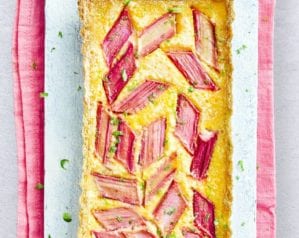
Rhubarb and custard brioche loaf
- Published: 1 Feb 23
- Updated: 18 Mar 24
The layers of this tear-and-share brioche loaf can simply be peeled away to enjoy. Between each sheet of pillowy dough sits a rhubarb custard that bakes into the fabric of the loaf giving a creamy, rich and tart finish. The crunchy, sugared crust is dotted with flecks of more rhubarb. It may be a labour of love to make, but it’s totally worth it!

Can’t get enough rhubarb and custard? Try the winning flavour combination in this impressive layer cake.
-
Serves 8-10
-
Hands-on time 1 hour 40 min, plus overnight proving and chilling. Oven time 1 hour 5 min
Ingredients
- 330g strong white bread flour, plus extra to dust
- Sachet (7g) easy bake yeast
- ½ tsp fine salt
- 30g light brown soft sugar
- 30ml whole milk
- 3 medium free-range eggs, beaten
- 1 tsp vanilla bean paste
- 160g unsalted butter, softened and diced
- Vegetable oil to grease
For the filling
- 200g rhubarb
- 110g golden granulated sugar, plus 1 tsp to dust
- 150ml whole milk
- 1 tsp vanilla bean paste
- 2 medium free-range egg yolks
- 1 tbsp cornflour
- ½ tsp fine salt
Specialist kit
- 900g/2lb loaf tin
Method
- Mix the flour, yeast, salt and sugar in a large bowl, then make a well in the centre. Heat the milk until lukewarm. Pour into the well, followed by the eggs and vanilla and mix into a smooth, stiff dough. Tip the dough onto a worksurface lightly dusted with flour or into a stand mixer with a dough hook attached. Knead for 5 minutes.
- Continue to knead the dough, adding the butter in a few cubes at a time, ensuring it’s incorporated before adding more – the dough will be quite sticky but will get easier to work with as you go, so don’t add more flour. This will take about 30 minutes by hand, or 6-8 minutes in a stand mixer on medium speed.
- Put the dough in a clean bowl and cover with a clean damp tea towel or an unused shower cap (see Eco Tip). Put somewhere warm for 1-2 hours until doubled in size.
- Once risen, knock the dough back, giving it a light knead. Cover the bowl again and put in the fridge overnight to rest.
- Meanwhile, heat the oven to 100°C fan/gas ½. Cut half the rhubarb into 1cm slices and the other half into 1cm cubes. Put half the slices in a small saucepan with 10g sugar, 1 tsp water and a pinch of salt, then put over a low-medium heat and simmer gently for about 8 minutes, or until the rhubarb is tender. Tip into a blender, whizz into a smooth purée, then set aside to cool and chill. Reserve the remaining sliced rhubarb for decorating the loaf.
- Put 50g of the sugar and 50ml water in the same saucepan. Set over a medium heat and bubble gently until the sugar has dissolved. Remove from the heat and stir in the diced rhubarb, ensuring it’s submerged, then set aside for 5 minutes to infuse. Line a baking tray with baking paper, then scoop out the soaked rhubarb and arrange it in a single layer on the tray, leaving as much liquid behind as possible. Bake for 15 minutes until dried out a little, then set aside to cool (with the syrup).
- Put the milk and vanilla in a pan and heat until steaming (but don’t boil). In a bowl, mix 1 egg yolk with the remaining 50g sugar, cornflour and salt with a wooden spoon. Gradually pour the hot milk mixture over the egg mixture, stirring constantly, until combined.
- Rinse out the pan then return the custard mixture to it. Cook over a medium heat, stirring constantly, until thickened. It’s ready when it holds its own shape in the pan. Pour into a bowl and cover the surface directly with baking paper. Set aside to cool, then stir in the rhubarb purée and chill.
- Grease the loaf tin with oil. Remove the brioche dough from the fridge and roll it out into a 40cm square on a lightly dusted work surface. Spread the rhubarb crème patisserie over the dough, then scatter over the lightly dried diced rhubarb. Use a large sharp knife to cut the dough into 4 even strips then layer the strips on top of each other, with the rhubarb side facing upwards. Cut this stack widthways into 4.
- Tuck the stacks into the loaf tin so they are sitting vertically in a single line. Cover with a damp tea towel or a greased, unused shower cap and set aside in a warm place to prove for 30 minutes, or until puffed up enough that it fills the tin.
- Heat the oven to 160°C fan/gas 4. Brush the brioche with the remaining egg yolk. Scatter over the remaining sliced rhubarb and 1 tsp sugar. Bake for 50 minutes, covering loosely with foil after 25 minutes to prevent the top getting too dark. Allow to cool in the tin for 10 minutes then turn out onto a cooling rack. Brush the reserved syrup over the brioche as it cools.
- Recipe from February 2023 Issue
Nutrition
- Calories
- 345kcals
- Fat
- 17g (9.6g saturated)
- Protein
- 8.1g
- Carbohydrates
- 39.2g (13.1g sugars)
- Fibre
- 1.5g
- Salt
- 0.5g
delicious. tips
Shower caps are a perfect reusable covering for bowls of proving dough – keep a clean one in your baking toolkit.
You can do everything up the end of step 8 the day before (and up to step 4 has to be done in advance to give the dough time to prove overnight).
Brioche dough is often trickier to prove due to the amount of butter incorporated into the dough – the butter blocks the strands of gluten forming, which are needed to hold the structure as it rises. To give your dough the best chance, create a warm steamy environment for it. Half-fill a roasting tin with just-boiled water and sit it in the base of the oven (the oven should be switched off or just with the light on). Put the bowl of dough on the shelf above and close the door to create a cosy, dough-friendly space.
Buy ingredients online
Rate & review
Rate
Reviews
Subscribe to our magazine
Food stories, skills and tested recipes, straight to your door... Enjoy 5 issues for just £5 with our special introductory offer.
Subscribe
Unleash your inner chef
Looking for inspiration? Receive the latest recipes with our newsletter










